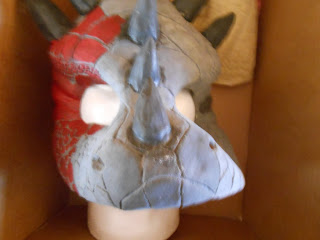Supplies:
- Alginate
- Hydrocal or other plaster
- Gauze or cheesecloth
- Vaseline
- Paper towels
- Straws
Tools:
- Mixing bowl
- Spatula or other stirrer
- Tarp
Prepping the Subject:
Begin by getting the subject ready. Rub Vaseline on any open hair. If you miss this either the subject’s hair will get pulled or the alginate cast that they sat for so long for will get torn and become useless, or both. Lay out a tarp over the area that you will be working on. For this demo we used a Massage Therapist’s table as it was comfortable and a good height to work with, although a reclining chair or even the floor would work as well. Make sure the subject can be comfortable and still for 30-45 minutes. Seal off the areas that are not to be cast. In this case that is the hair, the neck, and especially the ears. If casting ears be sure to add in something like cotton to keep alginate from entering the ear canal and solidifying there. Once ready, insert 2 sections of straw to the nose for the subject to be able to breathe. During the process keep contact with the subject to make sure everything is OK. For our demo yes/no questions and thumbs up/down worked well.Adding the first layer:
The first layer is a substance called Alginate. Alginate becomes a soft gel like layer and is good at picking up the small details for the cast. When mixing up the Alginate keep a few things in mind:
- Make sure the subject is ready as you only have about 8 minutes from the time you start mixing until it is set.
- Start with the amount of water needed and add powder to it until you have a pudding like mixture.
- Stir slowly in a figure 8 direction to get it mixed but keep clear of as many air bub- bles as possible.
When you mix up the Alginate follow the direc- tion on the type you end up getting. Different manufacturers will have slightly different mixing amounts but all of them will be Alginate and Wa- ter. Once it is mixed gently pour over the subject keeping clear of the straws. Be sure to pour as smooth as possible to keep air bubbles out and once poured slightly wiggle the stirrer on the al- ginate to agitate any remaining bubbles out. Let it sit until cured. Adding a layer of gauze will help the alginate to stay together while the next layer is added.
Adding the next layer:
The second layer is a plaster like substance called Hydrocal. It will provide a nice solid back- ing to the soft alginate and allow the last part of the process-making the positive of the cast. Like the Alginate when mixing add powder to water and mix slowly to avoid air bubbles. Also when pouring, go slow. It is possible to do this part in a couple of layers if needed. Remember though, this will warm up as part of the drying process and if it is on too thick your subject can get quite hot. Once it is cooled off and solid gently re- move the whole thing from the subject.
Creating the positive:
While the Alginate has captured the detail, it will not last long. Once the negative is set mix up some more Hydrocal, a little on the thin side, and pour into the Alginate to get into the detail. Then mix up some slightly thicker Hydrocal and pour it in to fill the whole space and let it set. Us- ing this layered process will help keep the detail of the face. Also, when pouring the Hydrocal go slow and try to keep pouring in the same spot to minimize the air bubbles that can become trapped and show on the final piece. While it is setting it will get hot. Let it sit unmoving until the fresh poured in Hydrocal becomes cool to the touch. At that point it can be pulled out of the negative mold and the casting is complete. Now clay can be used to mold on the face and create prosthetics that will fit the subject exactly.


















